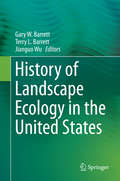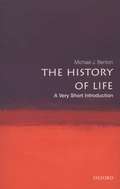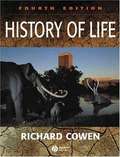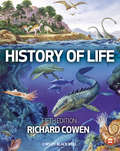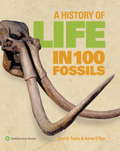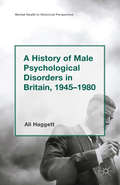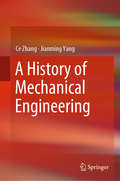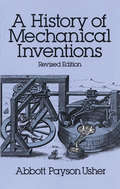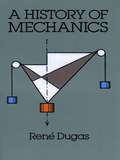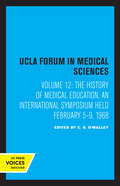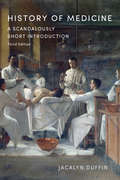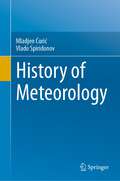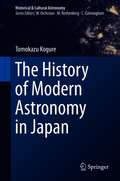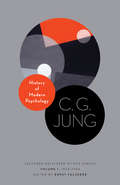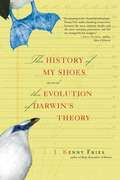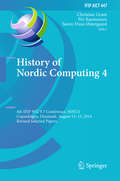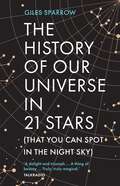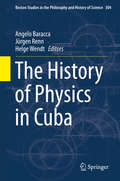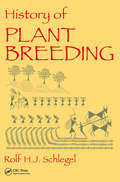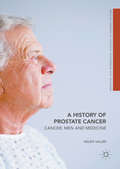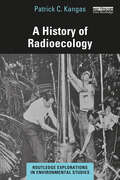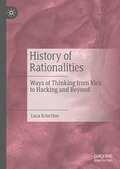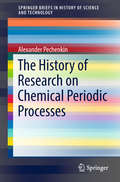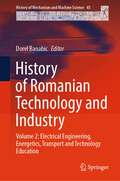- Table View
- List View
History of Landscape Ecology in the United States
by Gary W. Barrett Terry L. Barrett Jianguo WuThis book describes the emergence of landscape ecology, its current status as a new integrative science, and how distinguished scholars in the field of landscape ecology view the future regarding new challenges and career opportunities. Over the past thirty years, landscape ecology has utilized development in technology and methodology (e. g. , satellites, GIS, and systems technologists) to monitor large temporal-spatial scale events and phenomena. These events include changes in vegetative cover and composition due to both natural disturbance and human cause--changes that have academic, economic, political, and social manifestations. There is little doubt, due to the temporal-spatial scale of this integrative science, that scholars in fields of study ranging from anthropology to urban ecology will desire to compare their fields with landscape ecology during this intellectually and technologically fertile time. History of Landscape Ecology in the United States brings to light the vital role that landscape ecologists will play in the future as the human population continues to increase and fragment the natural environment. Landscape ecology is known as a synthesized intersection of disciplines; but new theories, concepts, and principles have emerged that form the foundation of a new transdiscipline.
The History of Life: A Very Short Introduction
by Michael J. BentonHere is the extraordinary story of the unfolding of life on Earth, told by Michael J. Benton, a world-renowned authority on biodiversity. Ranging over four billion years, Benton weaves together the latest findings on fossils, earth history, evolutionary biology, and many other fields to highlight the great leaps that enabled life to evolve from microbe to human--big breakthroughs that made whole new ways of life possible--including cell division and multicellularity, hard skeletons, the move to land, the origin of forests, the move to the air. He describes the mass extinctions, especially the Permian, which obliterated 90% of life, and he sheds light on the origins of human beings, and of the many hominids that went before us. He ends by pointing out that studying the past helps us to predict the future: what happens if the atmosphere warms by 5 degrees? What happens if we destroy much of the biodiversity on Earth? These things have happened before, Benton notes. We need only look to the distant past to know the future of life on Earth.
History Of Life
by Richard Cowen<P>This text is designed for students and anyone else with an interest in the history of life on our planet.<P> The author describes the biological evolution of Earth’s organisms, and reconstructs their adaptations to the life they led, and the ecology and environment in which they functioned.<P> On the grand scale, Earth is a constantly changing planet, continually presenting organisms with challenges. Changing geography, climate, atmosphere, oceanic and land environments set a stage in which organisms interact with their environments and one another, with evolutionary change an inevitable result.<P>The organisms themselves in turn can change global environments: oxygen in our atmosphere is all produced by photosynthesis, for example.<P> The interplay between a changing Earth and its evolving organisms is the underlying theme of the book.<P> The book has a dedicated website which explores additional enriching information and discussion, and provides or points to the art for the book and many other images useful for teaching. See: www.wiley.com/go/cowen/historyoflife.
History of Life
by Richard CowenThis text is designed for students and anyone else with an interest in the history of life on our planet. The author describes the biological evolution of Earth’s organisms, and reconstructs their adaptations to the life they led, and the ecology and environment in which they functioned. On the grand scale, Earth is a constantly changing planet, continually presenting organisms with challenges. Changing geography, climate, atmosphere, oceanic and land environments set a stage in which organisms interact with their environments and one another, with evolutionary change an inevitable result. The organisms themselves in turn can change global environments: oxygen in our atmosphere is all produced by photosynthesis, for example. The interplay between a changing Earth and its evolving organisms is the underlying theme of the book. The book has a dedicated website which explores additional enriching information and discussion, and provides or points to the art for the book and many other images useful for teaching. See: www.wiley.com/go/cowen/historyoflife.
A History of Life in 100 Fossils
by Paul D. Taylor Aaron O'DeaA History of Life in 100 Fossils showcases 100 key fossils that together illustrate the evolution of life on earth. Iconic specimens have been selected from the renowned collections of the two premier natural history museums in the world, the Smithsonian Institution, Washington, and the Natural History Museum, London. The fossils ahve been chosen not only for their importance in the history of life, but also because of the visual story they tell. This stunning book is perfect for all readers because its clear explanations and beautiful photographs illuminate the significance of these amazing pieces, including 500 million-year-old Burgess Shale fossils that provide a window into early animal life in the sea, insects encapsulated by amber, the first fossil bird Archaeopteryx, and the remains of our own ancestors.
A History of Male Psychological Disorders in Britain, 1945-1980 (Mental Health in Historical Perspective)
by Alison HaggettThis book is open access under a CC BY license and explores the under-researched history of male mental illness from the mid-twentieth century. It argues that statistics suggesting women have been more vulnerable to depression and anxiety are misleading since they underplay a host of alternative presentations of 'distress' more common in men.
A History of Mechanical Engineering
by Jianming Yang Ce ZhangThis book explores the history of mechanical engineering since the Bronze Age. Focusing on machinery inventions and the development of mechanical technology, it also discusses the machinery industry and modern mechanical education. The evolution of machinery is divided into three stages: Ancient (before the European Renaissance), Modern (mainly including the two Industrial Revolutions) and Contemporary (since the Revolution in Physics, especially post Second World War). The book not only clarifies the development of mechanical engineering, but also reveals the driving forces behind it – e.g. the economy, national defense and human scientific research activities – to highlight the links between technology and society; mechanical engineering and the natural sciences; and mechanical engineering and related technological areas.Though mainly intended as a textbook or supplemental reading for graduate students, the book also offers a unique resource for researchers and engineers in mechanical engineering who wish to broaden their horizons.
A History of Mechanical Inventions: Revised Edition
by Abbott Payson Usher"The book is without peer in its field." -- American ScientistIn this completely revised and enlarged edition of a classic work in the history of technology, a noted scholar explores the importance of technological innovation in the cultural and economic history of the West.Following an introductory discussion of the place of technology in economic history, the author offers a penetrating historical analysis of social change. Within this context he develops a theory of invention based on Gestalt psychology and a concept of social evolution as continuous development from antiquity to the present. Emphasis is placed on the role of economic forces in the development of technology, with scientific concepts also playing an important role in bringing about change.The latter part of the book focuses on the production and control of power in general, and in particular on a number of important operative mechanisms. Thus we read thought-provoking accounts of the technology of textile manufacture from primitive times, of water wheels and windmills, water clocks, and mechanical clocks, and the work of Leonardo da Vinci. The development of printing is carefully studied, not only for its intrinsic interest, but because of its importance for the history of science. Other topics include the production and application of power (1500-1830), machine tools and quantity production, the production and distribution of power since 1832, and the role of Asia Minor as a source of techniques which dominated the Middle Ages and the modern period as well.Thoroughly researched and cogently reasoned, A History of Mechanical Inventions belongs in the library of anyone interested in the history of science and invention, as well as the relationship of technology to economic and social history."Throughout the book there is constant proof of the author's wide learning and varied intellectual interests." -- The New York Times
A History of Mechanics
by René DugasIn this masterful synthesis and summation of the science of mechanics, Rene Dugas, a leading scholar and educator at the famed Ecole Polytechnique in Paris, deals with the evolution of the principles of general mechanics chronologically from their earliest roots in antiquity through the Middle Ages to the revolutionary developments in relativistic mechanics, wave and quantum mechanics of the early 20th century.The present volume is divided into five parts: The first treats of the pioneers in the study of mechanics, from its beginnings up to and including the sixteenth century; the second section discusses the formation of classical mechanics, including the tremendously creative and influential work of Galileo, Huygens and Newton. The third part is devoted to the eighteenth century, in which the organization of mechanics finds its climax in the achievements of Euler, d'Alembert and Lagrange. The fourth part is devoted to classical mechanics after Lagrange. In Part Five, the author undertakes the relativistic revolutions in quantum and wave mechanics.Writing with great clarity and sweep of vision, M. Dugas follows closely the ideas of the great innovators and the texts of their writings. The result is an exceptionally accurate and objective account, especially thorough in its accounts of mechanics in antiquity and the Middle Ages, and the important contributions of Jordanus of Nemore, Jean Buridan, Albert of Saxony, Nicole Oresme, Leonardo da Vinci, and many other key figures.Erudite, comprehensive, replete with penetrating insights, AHistory of Mechanics is an unusually skillful and wide-ranging study that belongs in the library of anyone interested in the history of science.
The History of Medical Education: An International Symposium Held February 5–9, 1968 (UCLA Forum in Medical Sciences #12)
by C. D. O’MalleyThis title is part of UC Press's Voices Revived program, which commemorates University of California Press’s mission to seek out and cultivate the brightest minds and give them voice, reach, and impact. Drawing on a backlist dating to 1893, Voices Revived makes high-quality, peer-reviewed scholarship accessible once again using print-on-demand technology. This title was originally published in 1970.
History of Medicine: A Scandalously Short Introduction, Third Edition
by Jacalyn DuffinJacalyn Duffin's History of Medicine is one of the leading texts used to teach the history of the medical profession. Emphasizing broad concepts rather than names and dates, it has also been widely appreciated by general readers for more than twenty years. Based on sound scholarship and meticulous research, History of Medicine incorporates pithy examples from a range of periods and places and is infused with the author’s characteristic wit. The third edition has been completely revised to highlight new scholarship on the past and incorporate significant medical events of the most recent decade – including new technologies, drug shortages, medical assistance in dying, and recent outbreaks of infectious diseases such as Ebola, H1N1, Zika, and COVID-19. The book is organized around themes of scientific and clinical interest, such as anatomy, physiology, pharmacology, surgery, obstetrics, medical education, health-care delivery, and public health. It includes a chapter on how to approach research in medical history, updated with new resources. History of Medicine is sensitive to the power of historical research to inform current health-care practice and enhance cultural understanding.
History of Meteorology
by Mladjen Ćurić Vlado SpiridonovThis book provides a detailed history of meteorology as a natural science, from an understanding of the Earth's early atmosphere to present-day advancements. In three parts, the book synthesizes developments in quantitative meteorology starting from its very early stages and progressively covers the invention of basic meteorology instruments while highlighting the various turning points and key figures who played roles along the way. The first part addresses the treatment of meteorology during early civilization. Part two goes into the early development of meteorology as a science. Part three covers the science's rapid progression and present-day status while addressing the primary technologies and methodologies used in a variety of areas like weather forecasting, remote sensing, and radar instrumentation. The target audience for the book is students and researchers interested in the history of meteorology as a science, and also general enthusiasts of the subject who have some background on the topic.
The History of Modern Astronomy in Japan (Historical & Cultural Astronomy)
by Tomokazu KogureThis book considers the history of modern astronomy and astrophysics in Japan by comparing with the development of astrophysics in western countries. Astrophysics essentially arose in three separate fields: astronomical spectroscopy, stellar structure, and survey of celestial objects.This book introduces readers to the state of astronomy back to the Tokugawa era (18th – 19th centuries), when the chief task of astronomers was limited to the calendar making. With the so-called Meiji revolution (1868), the situation drastically changed. The Meiji Government promoted the modernization of Japan by hiring numbers of foreign instructors in political, social, and cultural affairs, including Construction of Observatory and University. Then the foreign studies of Japanese researchers lasted for many years. After the Second World War, Japan experienced great social and economical growth allowing the constructions of large optical, radio, and space instruments. With this background astrophysics progressed and eventually flourished. The book ends by highlighting Japanese contributions to international collaboration up to the early 21st century.Readers of this book will understand how astrophysics has grown into one of the major sciences in Japan, and how the works of individual astronomers are contributing to the global advancement of knowledge of the universe.
History of Modern Psychology: Lectures Delivered at ETH Zurich, Volume 1, 1933-1934 (Philemon Foundation Series #14)
by C. G. Jung Ernst Falzeder Ulrich Hoerni Mark Kyburz John Peck Sonu ShamdasaniJung’s lectures on the history of psychology—in English for the first timeBetween 1933 and 1941, C. G. Jung delivered a series of public lectures at the Swiss Federal Institute of Technology (ETH) in Zurich. Intended for a general audience, these lectures addressed a broad range of topics, from dream analysis to yoga and meditation. Here for the first time in English are Jung’s lectures on the history of modern psychology from the Enlightenment to his own time, delivered in the fall and winter of 1933–34.In these inaugural lectures, Jung emphasizes the development of concepts of the unconscious and offers a comparative study of movements in French, German, British, and American thought. He also gives detailed analyses of Justinus Kerner’s The Seeress of Prevorst and Théodore Flournoy’s From India to the Planet Mars. These lectures present the history of psychology from the perspective of one of the field’s most legendary figures. They provide a unique opportunity to encounter Jung speaking for specialists and nonspecialists alike and are the primary source for understanding his late work.Featuring cross-references to the Jung canon and explanations of concepts and terminology, History of Modern Psychology painstakingly reconstructs and translates these lectures from manuscripts, summaries, and recently recovered shorthand notes of attendees. It is the first volume of a series that will make the ETH lectures available in their entirety to English readers.
The History of My Shoes and the Evolution of Darwin's Theory
by Kenny Fries<p>In The History of My Shoes, Kenny Fries narrates two stories: the development of the theory of "survival of the fittest," as articulated by Charles Darwin and Alfred Russel Wallace; and the history of his ever-changing, made-to-order, orthopedic shoes. <p>The famously important first story, as told by Kenny Fries, is a condensed and colorful account of the race between Darwin and Wallace to formulate their groundbreaking theories. <p>At the same time, Fries, a gay and disabled man, tells a deeply personal story of the evolving consciousness of his own "adaptations," represented by his shoes. As a child, Fries was abused by both his father and brother, and emerged into adulthood swaddled in ambiguities of self and memory. <p>These he has explored in his brutally frank memoir, Body, Remember. In this poetic, introspective book, Kenny Fries imaginatively illustrates how his identities intersect. He writes, "Much of my own work the past fifteen years has been concerned with the body, as both subject and metaphor; as the place where the personal becomes the universal; as the site of memory, language, and desire." <P>Although only the "fittest" may survive, Fries learns that adaptation and variation are critical to survival. What is deemed normal, or even perfect, are passing phases of the ever-changing embodiment of nature in our world. In the end, Darwin and Wallace's discoveries resonate with Fries's own story in The History of My Shoes.
History of Nordic Computing 4
by Christian Gram Per Rasmussen Søren Duus ØstergaardThis book constitutes the refereed post-proceedings of the 4th IFIP WG 9. 7 Conference on the History of Nordic Computing, HiNC 4, held in Copenhagen, Denmark, in August 2014. The 37 revised full papers were carefully reviewed and selected for inclusion in this volume. The papers focus on innovative ICT milestones that transformed the nordic societies and on the new ideas, systems and solutions that helped creating the welfare societies of today, in particular solutions and systems for public services, e. g. , tax, social benefits, health care and education; solutions and systems for the infrastructure of the society, e. g. , banking, insurance, telephones, transport and energy supply; and technologies and IT policies behind the major IT milestones, e. g. , user centric innovation, programming techniques and IT ethics. They are organized in topical sections on IT policy, infrastructure, public services, private services, telesystems, health care, IT in banking, transport and IT technology.
The History of Our Universe in 21 Stars: (That You Can Spot in the Night Sky)
by Giles SparrowPreviously published as A History of the Universe in 21 Stars.'REVISED AND UPDATED ___'A wonderful book about the science, history and mythology of 21 stars (and 3 impostors).' Dr David WhitehouseLook up on a clear evening, and you'll see thousands of stars shining in the night sky, each telling a story of their own. With star maps to help easily identify key celestial bodies, astronomer Giles Sparrow takes 21 stars (and three impostors) to look at what each pinprick of light can tell us about the birth, life and death of our universe.From red giants to supernovae and from stellar cities to our own Sun, The History of Our Universe in 21 Stars shows how the lights we see in the sky can help us unravel the mysteries of the cosmos.'Beautifully written and extremely accessible ... It's extremely difficult to put down! Gemma Lavender
The History of Physics in Cuba
by Angelo Baracca Jürgen Renn Helge WendtThis book brings together a broad spectrum of authors, both from inside and from outside Cuba, who describe the development of Cuba's scientific system from the colonial period to the present. It is a unique documentation of the self-organizing power of a local scientific community engaged in scientific research on an international level. The first part includes several contributions that reconstruct the different stages of the history of physics in Cuba, from its beginnings in the late colonial era to the present. The second part comprises testimonies of Cuban physicists, who offer lively insights from the perspective of the actors themselves. The third part presents a series of testimonies by foreign physicists, some of whom were directly involved in developing Cuban physics, in particular in the development of teaching and research activities in the early years of the Escuela de Física. The fourth part of the volume deals with some of the issues surrounding the publishing of scientific research in Cuba. Cuba's recent history and current situation are very controversial issues. Little is known about the development and status of higher education and scientific research on the island. However, Cuba has one of the highest proportions in the world of people with a university degree or doctorate and is known for its highly developed medical system. This book focuses on a comprehensive overview of the history of the development of one specific scientific discipline: physics in Cuba. It traces the evolution of an advanced research system in a developing country and shows a striking capacity to link the development of modern research with the concrete needs of the country and its population. A little known aspect is the active participation of several "western" physicists and technicians during the 1960s, the role of summer schools, organized by French, Italian, and other western physicists, as well as the active collaboration with European universities.
History of Plant Breeding
by Rolf H. SchlegelWhile there has been great progress in the development of plant breeding over the last decade, the selection of suitable plants for human consumption began over 13,000 years ago. Since the Neolithic era, the cultivation of plants has progressed in Asia Minor, Asia, Europe, and ancient America, each specific to the locally wild plants as well as the ecological and social conditions. A handy reference for knowing our past, understanding the present, and creating the future, this book provides a comprehensive treatment of the development of crop improvement methods over the centuries. It features an extensive historical treatment of development, including influential individuals in the field, plant cultivation in various regions, techniques used in the Old World, and cropping in ancient America. The advances of scientific plant breeding in the twentieth century is extensively explored, including efficient selection methods, hybrid breeding, induced polyploidy, mutation research, biotechnology, and genetic manipulation. Finally, this book presents information on approaches to the sustainability of breeding and to cope with climatic changes as well as the growing world population.
A History of Prostate Cancer: Cancer, Men and Medicine (Medicine and Biomedical Sciences in Modern History)
by Helen ValierThis book offers a comprehensive and inclusive insight into the history of prostate cancer and its sufferers. Until recently, little practical help could be offered for men afflicted with the devastating diseases of the genitourinary organs. This is despite complaints of painful urination from aging men being found in ancient medical manuscripts, despite the anatomical discoveries of the European Renaissance and despite the experimental surgical researches of the eighteen and nineteenth centuries. As diseases of the prostate, including prostate cancer, came to be better understood in the early twentieth century, therapeutic nihilism continued as curative radical surgeries and radiotherapy failed. The therapeutic 'turn' came with hormonal therapies, itself a product of the explosive growth of U. S. biomedicine from the 1940s onwards. By the 1990s, prostate cancer screening had become a somewhat ubiquitous but controversial feature of the medical encounter for American men as they aged, which greatly influenced the treatment pathways and identity of the male patient: as victim, as hero, and ultimately, as consumer.
History of Rabies in the Americas: Insights to Specific Cross-Cutting Aspects of the Disease in the Americas (Fascinating Life Sciences)
by Charles E. RupprechtRabies is one of the oldest known pathogens, is incurable, and has the highest fatality rate of all infectious diseases. The Americas is the only region with bat rabies virus, including vampire bat rabies. The region is rich in cultural references and notable for many discoveries in the field, including the current vaccine potency test, diagnostic assay, conception of oral vaccines for wildlife, the first human survivor and the first successful canine rabies program executed at a broad level. Rabies remains the most important viral zoonosis, with tens of thousands of human fatalities and tens of millions of exposures annually, which can be used to model for other pathogens, such as COVID-19. There is an international effort to eliminate human rabies caused by dogs over the next decade, and the Americas represent the primary region with the greatest proof-of-concept evidence to accomplish this goal. This two-volume set addresses the medical history and modern results of rabies in countries throughout the Americas, including the implications of and on cultural, economic, sociological, and research developments in the region. Volume I presents an overview of concepts critical to the study of rabies in the region, including evolutionary aspects, reservoir ecology and control, elimination efforts, vaccine development, and disease hallmarks and progression. It also analyzes the long-term cultural, social, and economic impacts of the disease in the Americas.
A History of Radioecology (Routledge Explorations in Environmental Studies)
by Patrick C. KangasThis book presents a history of radioecology, from World War II through to the critical years of the Cold War, finishing with a discussion of recent developments and future implications for the field. Drawing on a vast array of primary sources, the book reviews, synthesizes and discusses the implications of the ecological research supported by the Atomic Energy Commission (AEC) of the United States government, from World War II to the early 1970s. This was a critical period in the history of ecology, characterized by a transition from the older, largely descriptive studies of communities of plants and animals to the modern form of the science involving functional studies of energy flow and mineral cycling in ecosystems. This transition was in large part due to the development of radioecology, which was a by-product of the Cold War and the need to understand and predict the consequences of a nuclear war that was planned but has never occurred. The book draws on important case studies, such as the Pacific Proving Grounds, the Nevada Test Site, El Verde in Puerto Rico, the Brookhaven National Laboratory and recent events such as the nuclear disasters at Chernobyl and Fukushima. By revisiting studies and archived information from the Cold War era, this book offers lessons from the history of radioecology to provide background and perspective for understanding possible present-day impacts from issues of radiation risks associated with nuclear power generation and waste disposal. Post-Cold War developments in radioecology will be also reviewed and contrasted with the AEC-supported ecology research for further perspectives. This book will be of great interest to students and scholars of radioecology, environmental pollution, environmental technology, bioscience and environmental history.
History of Rationalities: Ways of Thinking from Vico to Hacking and Beyond
by Luca SciortinoOver time, philosophers and historians of science have introduced different notions of 'ways of thinking'. This book presents, compares, and contrasts these different notions. It focuses primarily on Ian Hacking’s idea of 'style of reasoning' in order to assess and develop it into a more systematic theory of scientific thought, arguing that Hacking’s theory implies epistemic relativism. Luca Sciortino also discusses the implications of Hacking’s ideas for the study of the problem of contingency and inevitability in the development of scientific knowledge
The History of Research on Chemical Periodic Processes (SpringerBriefs in History of Science and Technology)
by Alexander PechenkinThis book offers a survey of the historic development of selected areas of chemistry and chemical physics, discussing in detail the European, American and Russian approaches to the development of chemistry. Other key topics include the kinetics and non-linear thermodynamics of chemical reactions and mathematical modeling, which have found new applications in the theory of dynamical systems. The first observations of the periodicity of chemical reactions were lost in the mist of time. In the second half of the 19th century, the phenomenon of chemical periodicity was studied in relation to electrochemistry, solutions and colloids. Discovered in the late 19th century, Liesegang rings are still enigmatic and remain attractive for researchers. However, the discovery of the Belousov–Zhabotinsky reaction marked the successful culmination of the efforts to find a true chemical oscillatory reaction. The book investigates chemical phenomena that were neglected in the past, but have been rediscovered, placing them into a new conceptual framework. For example, it notes that William Bray, who discovered the first oscillatory homogeneous reaction in 1921, was influenced by the first bio-mathematicians who predicted chemical oscillations in homogeneous systems.
History of Romanian Technology and Industry: Volume 2: Electrical Engineering, Energetics, Transport and Technology Education (History of Mechanism and Machine Science #45)
by Dorel BanabicThis volume showcases the valuable achievements of the Romanian technology and industry worldwide. It started from the premise that the history of Romanian technique is scarcely known outside the borders of Romania. The main Romanian contributions to the world’s technological heritage are missing, except for a few names in the field of aviation, from the great encyclopedias and dictionaries published worldwide. This is due, among other reasons, to the insufficient promotion in widely spoken languages of the history of Romanian technology. The multidisciplinary approach of the volumes means that the field of technology had to be split into several branches. The present volume includes the following industries: electrical engineering, energy technology, biomedicine, maritime and rail transport, automotive industry, aviation. The history of engineering societies, of engineering education, of intellectual property, and of inventions, as well as a synopsis of the personalities of Romanian engineering have been tackled in separate chapters. For each field, are engaged the collaboration of authors who have already published a history of their field. Certain chapters were drafted with the aid of specialists who have played the part of policy makers in the elaboration of development strategies for Romania and who are familiar not only with the facts and the history of their field, but also with the ‘philosophy’ behind its development.
